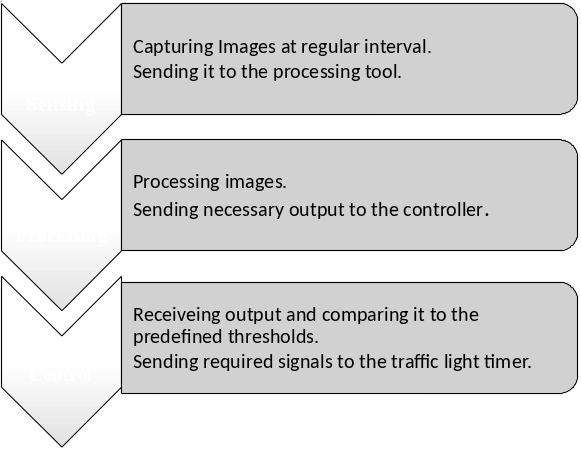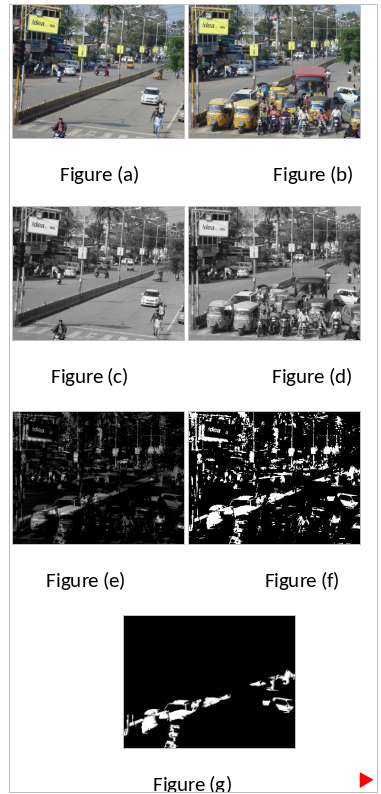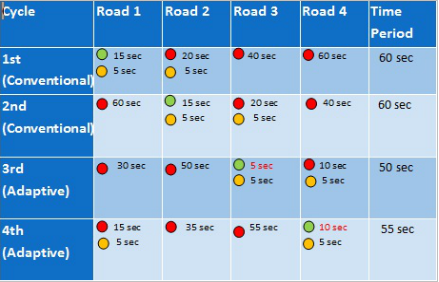The current traffic control system (TCS) in the metro cities of India are inefficient due to randomness in the traffic density pattern throughout the day. The traffic signal timers have a fixed time period to switch traffic between different directions. Due to this, the vehicles have to wait for a long time span even if the traffic density is very less. If the traffic signal timer (TST) can be programmed to be manipulated with the continuously varying traffic density, the problem of traffic congestion can be reduced to a significantly lower levels. This article is targeted to four ways intersection square’s traffic signals and is based on one of the winning entries of EUREKA, the paper-presentation event organized in Techkriti 14, IITK.
The proposed system adapts the traffic signal timer according to the random traffic density using image processing techniques. This model uses high resolution cameras to sense the changing traffic patterns around the traffic signal and manipulates the signal timer accordingly by triggering the signals to the timer control system. The increase and decrease in traffic congestion directly depends upon the control on the flow of traffic, and hence, on the traffic signal timer. Due to this phenomenon, the vehicles have to face an irregular delay during transit in the urban areas. At present, the traffic control systems in India, lack intelligence and act as an open-loop control system, with no feedback or sensing network. The aim in this work was to improve the traffic control system by introducing a sensing network, which provides a feedback to the existing network; so that it can adapt the changing traffic density patterns and provides necessary signals to the controller in real time operation. Our major objective is to optimize the delay in transit of vehicles in odd hours of the day.
The objective is to design an intelligent traffic signal control system algorithm with the use of sensing devices and image processing systems. The captured images were to be processed in real time using an image processing toolkit such as MATLAB®, and various parameters have to be calculated to estimate the density of vehicle traffic in all four directions. The controller has to execute the developed algorithm on the traffic signal timer to vary its time period.
This autonomous control system consists of four major entities,
- High resolution imaging device.
- Image processing tool –MATLAB® R2013a.
- Microcontroller based traffic light timer control.
- Wireless transmission using UART principles.

The Image Processing Algorithm proceeds in the following way. Assuming day time analysis, four snapshots of each of the four directions is captured, with the help of high resolution cameras, when there is negligible density of vehicles on the road. These four images act as a reference. For the remaining part of the day the images are captured at regular interval of 5 seconds and then compared with the reference images using image processing techniques described through images below.

Fig (a) represents the reference image in one direction of a four way intersection. Fig (b) is the real-time image which is captured at regular interval. Now both, fig (a) and fig (b) are converted into greyscale using rgb2gray command in MATLAB, as shown in fig (c) & fig (d) respectively. Now for estimation of real-time traffic density we subtract fig (c) from fig (d) Using imsubstract command, which results in fig (e). Now as it requires to define the threshold levels for digital signal processing, we use graythresh command and for better differentiability fig (e) is converted into a binary image using im2bw command as shown in fig (f). Still to remove the low density areas, such as birds, banners, streetlights etc., a filter is required for optimised results. This filtering process is executed using command bwareopen which is shown in fig (g). The white portion on the image represents the traffic density, so the percentage of white portion is calculated and its value is send to controller for further calculations and timer manipulation.
Timing Diagram
 The table shown represents the timing cycle of the four way intersection. The first two cycles are the conventional timing cycles which exist in fixed timer traffic control systems. The last two cycles are optimised with ATLTC system, and it is evident from the experimental data that the time can be saved in the multiples of 5 seconds.
The table shown represents the timing cycle of the four way intersection. The first two cycles are the conventional timing cycles which exist in fixed timer traffic control systems. The last two cycles are optimised with ATLTC system, and it is evident from the experimental data that the time can be saved in the multiples of 5 seconds.
The major advantage of an ATLTC system is its robustness and ease of installation. Queue length estimation with image processing techniques will prove to be more accurate than the conventional inductive loop detectors& Infrared sensors. An ATLTC system would also help in reduction of noise and air pollution levels, and also result in low fuel consumption. This system demonstrates that with least resources and maintenance, it is capable of stabilizing traffic in 4-way intersection squares in much less cycles then in conventional fixed time timers.
There exists a huge scope of advancements in the present form of image processing based- adaptive traffic control system. With integration of techniques such as display boards at intersections, solar power sources, synchronization of all traffic squares in the city and high resolution night vision imaging devices, the accuracy and efficiency of the system can be greatly increased. In Indian situations, a system has to be accurate enough to detect illegally stopped or parked vehicles on the dead side of the road, for which adaptive image cropping techniques will be required. The limitation of ATLTC system is that it is neither programmed to prioritize the authorized emergency vehicles nor to detect accidents on the intersection, for which the concepts of digital signal processing along with RFID tags may be needed.
References
[1] Andrew P. Nichols ‘Adaptive Traffic Signal Control’ WVDOH/MPO/FHWA Planning Conference 10/3/2012.
[2] Arif A. Bookseller, Rupali R Jagtap ‘Image processing based Adaptive Traffic Control System’, Second International Conference. on Emerging Trends in Engineering (SICETE), IOSR Journal of Electronics and Communication Engineering (IOSR-JECE) , PP: 33-37.
[3] Emin Basic, Yasser De Jesus, Ashrafur Rahman ‘Adaptive Signal Control Technology: Current Practice and Comparison’, Intelligent Transportation Society of Connecticut, Student Research Project, Spring 2012.
[4] OvidiuTomescuIlonaMadalinaMoise, Alina Elena Stanciu, LulianBatros‘Adaptive Traffic Light Control System using Adhoc Vehicular Communication Networks’ U.P.B. Sci. Bull., Series D, Vol. 74, Iss. 2, 2012.

 © Nerd Magazine, IIT Kanpur,2017. All rights reserved.
© Nerd Magazine, IIT Kanpur,2017. All rights reserved.
Comments
comments powered by Disqus